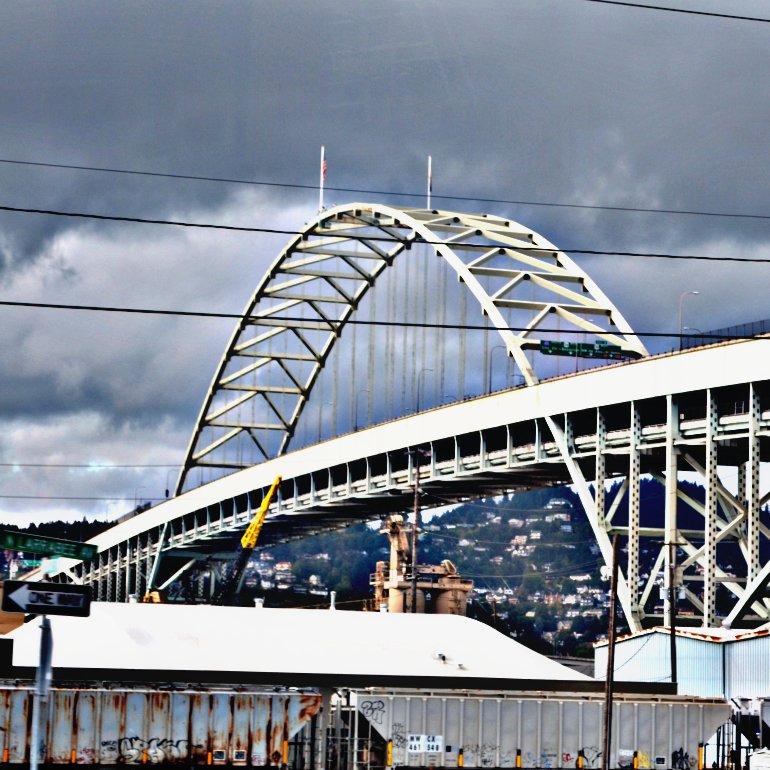
The Fremont Bridge as seen from Interstate Avenue, northward bound on the Yellow Line MAX train. I'm looking toward the Northwest Hills. I have cropped and altered it with Picnik's HDR-ish special effect.
Found on the Internet:
The Fremont Bridge is a steel tied arch bridge over the Willamette River located in Portland, Oregon. It carries Interstate 405 and US 30 traffic between downtown and North Portland where it intersects with I-5. It has the longest main span of any bridge in Oregon and is the second longest tied arch bridge in the world (after Caiyuanba Bridge across the Yangtze River, China). The bridge was named for John Charles Frémont, though a nearby street was previously named Fremont Street in honor of the same individual.
The bridge has two decks carrying vehicular traffic, each with four lanes. The upper deck is signed westbound on US 30 and southbound on I-405. The lower deck is signed eastbound on US 30 and northbound on I-405. The upper deck is closed to vehicular traffic annually for the Providence Bridge Pedal, a fundraiser which, in 2011, benefited the Providence (Hospital) Heart and Vascular Institute and the Bicycle Transportation Alliance. (One of these days I'm going to get brave enough to walk the bridges included in this event.)
The Fremont Bridge is 2,154 feet long, with its longest span at 1,255 feet. The clearance below the bridge is 175 feet, while the vertical clearance is 18.3 feet--I assume that means clearance between the two decks. It crosses the Willamette River and surface streets in Portland.
Due to the public's dissatisfaction with the appearance of the Marquam Bridge, the Portland Art Commission was invited to participate in the design process of the Fremont. The improvement in visual quality resulted in a bridge that was nearly six times as expensive as the purposely-economical Marquam Bridge. Designers modeled the bridge after the Port Mann Bridge in Vancouver, British Columbia.
In October of 1971, while still under construction, a crack was found on the west span girder that required a $5.5 million redesign and repair. The main span of the bridge was built in California then assembled at Swan Island, 1.7 miles (2.7 km) downstream. After completion it was floated into place on a barge.
On March 16, 1973 the 6,000 ton steel arch span was lifted 170 ft (52 m) using 32 hydraulic jacks. At the time, it was listed in the Guinness Book of World Records as the heaviest lift ever completed. The bridge was opened on November 15, 1973 at a final cost of $82 million, most of which was financed by the Federal Highway Administration.
In 1976, an American flag and an Oregon flag were added atop the structure as part of the bicentennial celebration for the United States.[4] The 15 feet (4.6 m) by 25 feet (7.6 m) flags are attached to 50-foot (15 m) tall flagpoles at the crest of the arches.
The Fremont Bridge was also the 26th Peregrine falcon nest site designated in Oregon after the raptor was placed on the U.S. Threatened and Endangered Species list in 1970.
No comments:
Post a Comment